Follow this packing list if you’re backpacking through Southeast Asia
You’re going to Southeast Asia but don’t know what to pack ? No matter what your travel itinerary might be, 4 weeks or 6 months, we’ve got a list of travel essentials you cannot forget on your trip.
Packing for a long trip might be pretty confusing, especially when the said trip will last for weeks or months. But fear not, we have all tips and tricks here for you so there is nothing standing in the way of your trip through Southeast Asia.
First things first: What to pack when traveling during a pandemic
Traveling is supposed to be fun and exciting. During a pandemic however it can get stressful. To not let travel anxiety take over, you should be prepared which is why we have a thorough checklist for you.
- Check the current travel restrictions and entry requirements for your destination
- Make sure you have valid vaccine and COVID–19 test certificates
- Pack enough masks and hand sanitizer to get you through the first few days of your trip
- Pack a few home COVID-19 test kits
- Stock up on a COVID-19 travel insurance
- Make sure all your vaccines are up to date (not just the COVID-19 one)
What other documents to pack when traveling through Southeast Asia and where to keep them
Unless you have an extra pair of eyes on the back of your head, make sure you don’t put all your money and important documents in one place inside your backpack. It’s best to have your valuables distributed among various places on you .
If an option, order an extra bank card that is either attached to your existing account or get a new account with a new card altogether. Having two accounts, each with own bank card, came to my rescue when I lived in Southeast Asia and my wallet was stolen from my backpack.
The same goes for all of your important documents. Make copies or scans of them and save them in the cloud. Be it your passport, driver’s license, travel insurance, or marriage certificate — you don’t want to lose them.
What to pack for Southeast Asia before it hits the fan…

Pack wisely, especially if your luggage isn’t too large — Shutterstock
They say that if you don’t get food poisoning while in Southeast Asia it’s like you’ve never even been there. Fair enough, I guess I’ve never been there then.
What probably saved my butt — literally — back then was a daily dosage of probiotics . I didn’t encounter a single day of please-kill-me-now moments in the four months I lived there, even though there was some highly sketchy food and poor hygiene involved.
Just in case though, you should bring a pack of activated charcoal tablets or special medicine that’s suitable for the more resistant strains of bad gut bacteria and viruses that could cause discomfort.
Going hand-in-hand with avoiding unnecessary medical conditions is hand sanitizer . I also fell in love with soap sheets , which are super easy to carry around. Just make sure you have dry hands before you try to take a sheet, otherwise, they all get wet and stick together.
And the last thing you need — depending on if you’re planning to visit areas with abundant numbers of mosquitoes or the other rather unpleasant and potentially disease-carrying insects — is a good mosquitoes repellent . It’s best to ask your local pharmacist and get one that’s intended for use in Southeast Asia.
If you’re a light sleeper, just like me, bring a pair of earplugs (or keep those they give you on the airplane). Peaceful blue lagoons only become a reality once you arrive at them, otherwise, Southeast Asia can be a noisy mess.
I cannot speak for all countries and all cities in Southeast Asia, but Asians tend to get up early. Very early. Too early for my taste. And in their homes, they keep animals that are noisy, like roosters.
What to pack for Southeast Asia so you don’t run out of juice…

Want to keep on using your devices? Pack a portable charging device so you never run out of juice — Shutterstock
Most places in Southeast Asia are fairly developed, however, chances are you’ll find yourself struggling to power up your devices. Remote areas and smaller islands can be especially affected by power outages or natural occurrences. Make sure to carry a portable charging device with you.
Another reason to bring one is that power outlets vary from country to country so it’s better to be on the safe side.
Clothes to pack for Southeast Asia so you don’t run into trouble

May the sarong be with you. Just in case — Shutterstock
Clothing conventions are hard to figure out — especially when trying to figure out which ones to pack when backpacking — but it’s more than advisable to get them right. Even within one country in Southeast Asia, there can be differences in what you’re expected to wear. Usually, women have to mind their clothes more than men.
Religious sites in particular apply stricter rules with regard to clothing. While at a beach in Bali it might be okay to wear bikinis, but a few kilometers away it might be totally inappropriate. Avoid looks and remarks by wearing a sarong or some more proper clothes that will cover you from your shoulders to at least your knees.
Even if you’re the more minimalist packer, it’s sometimes better to pack a little more than less. If you really run out of space, you can always buy a sarong once you get to Southeast Asia.
Costs to consider when backpacking through Southeast Asia so you don’t run out of money

If you want to travel as cheaply as possible to multiple cities, check our NOMAD travel search tool. We combine destinations in a way to give you the best and cheapest itinerary possible — Shutterstock
How much money you should budget for your trip will depend on your timeframe and way of life. You also need to consider where you are going, touristy destinations will eat through your money much quicker than deserted islands.
If you want to travel on a budget, consider how much you spend in your daily life at home and compare that with local prices.
On top of spending money, you will need to count in costs for accommodation, transportation, and meals.
My advice is to research every country individually, get a broad itinerary, such as how to get to each destination and the cost of local transportation, as well as cheap flights .
25 Pro Tips For Backpacking Asia (Based On 1 Year+ Of Travel)
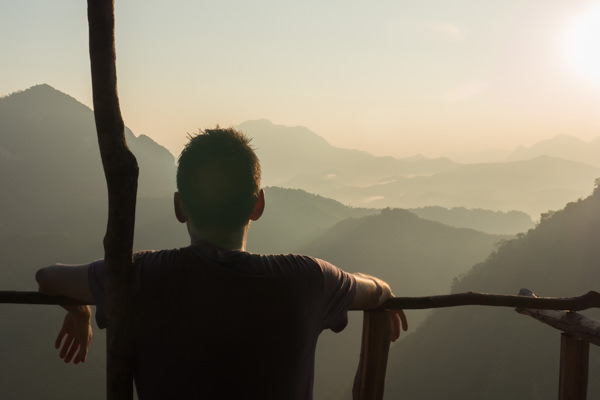
I found this out the hard way on my first Southeast Asia backpacking trip. I had overpacked, planned poorly, and missed out on a lot of great travel opportunities due to my inexperience!
To help you better prepare for your trip, let me share with you 25 top tips based on my Southeast Asia backpacking trips — after having spent more than a year combined travelling throughout the region.
1. Pack light (seriously!)
The first thing you’ll want to do is make sure you’ll be light on your feet.
I know it’s kinda scary to venture off to some whole other part of the world you may not have ever been before, but you don’t have to pack like you’re a doomsday prepper. Relax… you’re gonna be fine.
Remember that there are plenty of shops in Asia where you can still buy things if needed. You don’t need to pack tons of travel gadgets or specific gear only ‘just in case’. Often that’s just your fears/worries leading you to pack a lot of unimportant items.
I’ve met a lot of backpackers in Southeast Asia with way too huge and heavy backpacks who regretted packing too much. Trust me that it sucks to be slogging around everywhere like a mule!
Just pack one week’s worth of clothes plus your travel essentials. If you need some tips, I have a guide on how to pack light. Consider taking just a carry-on bag of around 40 liters in size; most of Southeast Asia is quite hot and sunny so you really have a lot fewer clothes to pack than for some winter destination. Don’t pack any pillows, sleeping bags, or mosquito nets. You don’t need them.
A lightweight travel backpack is easier to carry, keeps you agile, makes it way more difficult to lose stuff, and saves you money on airline baggage allowance. Here are some suggested backpacks if you don’t already have one you like.
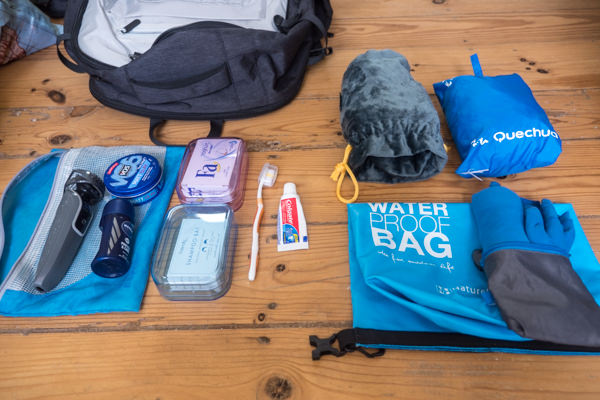
2. Do bring some warm clothes
While you may be going to the tropics, it can get cold in Southeast Asia sometimes!
A hoodie and trousers will definitely be needed for any mountains, hill stations, heavily air-conditioned environments, or in the northernmost parts of the region where it can get colder. If you’re in north Vietnam or north Laos in winter, it can be especially chilly.
Even in the sweltering cities, shopping malls and cinemas can be so air-conditioned you’ll freeze your tits off without any extra layer, so every now and then having some warm clothes can come in handy.
3. Rainy season is different everywhere
If you’re planning a Southeast Asia backpacking trip you will no doubt become aware of there being such a thing called the rainy season.
In the tropics, the rainy or monsoon season can be very intense; it’s typically a period of several months during which there can be heavy showers every day. Travelling during rainy season can be a bit of a mixed bag; there are fewer crowds but the weather is less predictable too. I was once in the Philippines at the tail end of monsoon season and suffered a whole week of continuous rain. Once, in an outdoor bar in Thailand, the rain was so intense it knocked glasses and bottles off the tables.
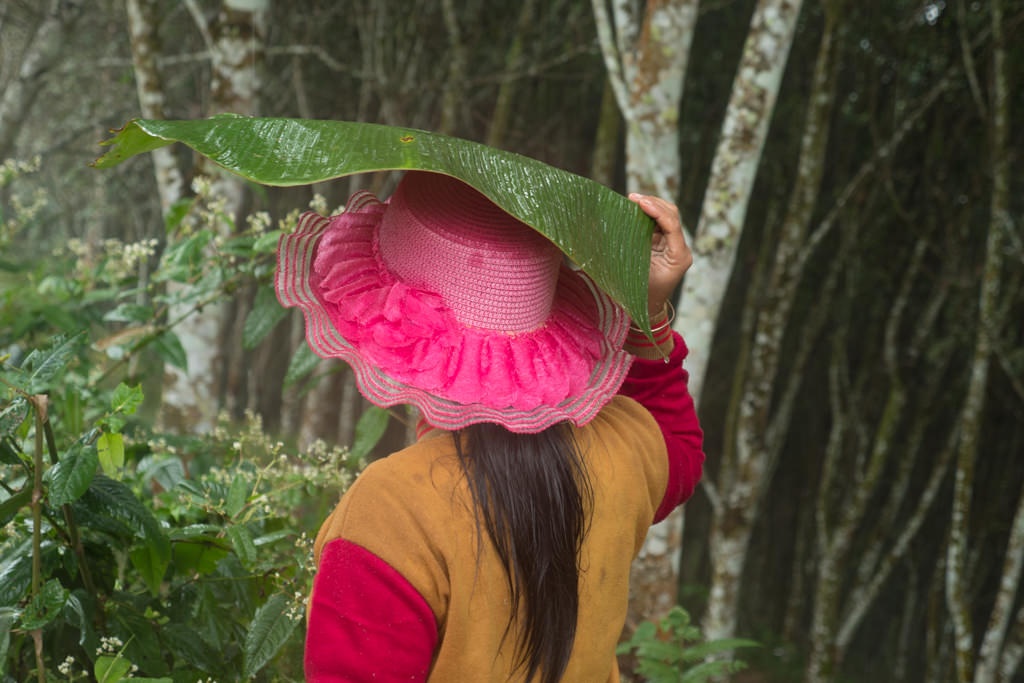
It’s true that it doesn’t necessarily rain all the time during the rainy season (it’s usually a few hours in the morning followed by clear skies) but many travellers still try to avoid it if they can.
Luckily, rainy or monsoon season doesn’t happen at the same time everywhere. For example, in Thailand it may be rainy season on the east coast but not on the west coast. Or when it’s monsoon in Malaysia, it’s dry season on Bali. So, if you’re planning a longer backpacking trip, you can hop around the region in such a way that you still enjoy the best weather in each country.
4. Definitely stay in hostels
Backpacking in Asia isn’t half the fun if you don’t stay in hostels at least some of the time. The hostel scene is fantastic, with so many hostels offering a homely and social atmosphere. Hostels are places where you can rest, chat with other travellers, get tips about places you are going, and share your best travel stories.
The hostels in some specific parts of Southeast Asia can be very party-focused though. For example, on the island of Koh Phi Phi in Thailand, many of the hostels are Ozzie-filled drinkfests, which may or may not be the scene you’re looking for.
I personally like more social traveller hostels, which you can find pretty much anywhere. If you’re looking for a specific type of atmosphere, it’s not hard to find based on the reviews and photos of each establishment.
If you stay in dorms the hostels can save you quite a bit of money, but even if you stay in private rooms you can benefit from the communal atmosphere they provide. There are so many fun adventures I’ve had in Asia that I would not have done or even known about if I hadn’t stayed in hostels.
5. Or… don’t stay in hostels!
If you don’t need to be among other travellers all the time, then guesthouses and B&Bs also offer great and affordable places to stay.
In places that aren’t yet super touristy, you can often easily nab a sweet little bungalow for very little money. For instance, I stayed in many bamboo bungalows in Laos for around $10 a night.
You can usually find the best budget accommodation on Booking.com and Agoda as these platforms are open to smaller hotels and local guesthouses. It’s often worth trying Agoda over Booking.com; the two sites are owned by the same company, but Agoda is specialized in the Asia region.
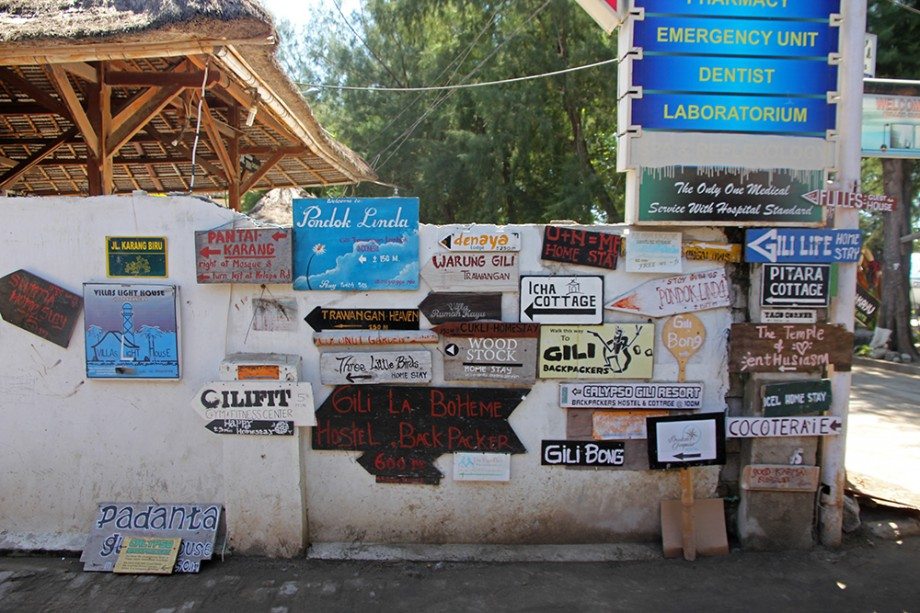
6. Avoid overplanning
It’s definitely helpful to do some research in advance and create some wishlists for what you want to see and do. But… plans will also inevitably change when you get there. And you don’t have to know every step of your journey in advance!
One of the fun aspects of backpacking is that you can embrace the unpredictability of travel. You might hear of a cool place from another traveller and decide to spend an extra day to check it out, or maybe the weather reports or transit connections make you reconsider your intended travel route.
If you don’t book all your accommodation ahead of time you can easily make decisions on the fly. Often some of the best things I’ve done in Southeast Asia I had not planned ahead at all. Improvising is relatively easy in this part of the world and is fairly low-stress thanks to there being so many accommodation and transportation options.
If you still would like to create a rough outline for your trip, check out my Southeast Asia backpacking itineraries.
7. Book places one step ahead
That said, booking your accommodation can still be a good idea if you do it one step ahead while you travel. These days I book my places on Booking.com or Agoda pretty much 80% of the time as it’s just so convenient and you’ll be assured of a room in a high-rated place.
Some travellers just show up to destinations to find something there and then. This can often get you cheaper deals than you can find online. If you’re with a group, you can easily split up and look at the different options in town, then decide on the best one.
Then get my top-rated book Travel the World Without Worries, which helps you pack, plan, and prepare for your backpacking adventure — and puts you in the right mindset to make the most of your trip. Read the first chapter for free.
8. Stay in the moment
I find that staying at least somewhat disconnected during your backpacking trip can really enhance your overall experience. The journey can feel much more like an adventure if you’re not occupied with sharing everything instantly online.
Mobile SIM cards with cheap internet data are widely available, but I don’t usually buy one simply to force myself to stay offline a lot more. You can still use the MAPS.me app for offline wayfinding (I highly recommend installing this app!) and then make do with the occasional WiFi only.
A backpacking trip can give you a rare chance to reboot your mind. Travel can make you forget about work, or the news, or all the dumb stuff on the internet. Backpacking Southeast Asia will give you an incredible opportunity for a digital detox.
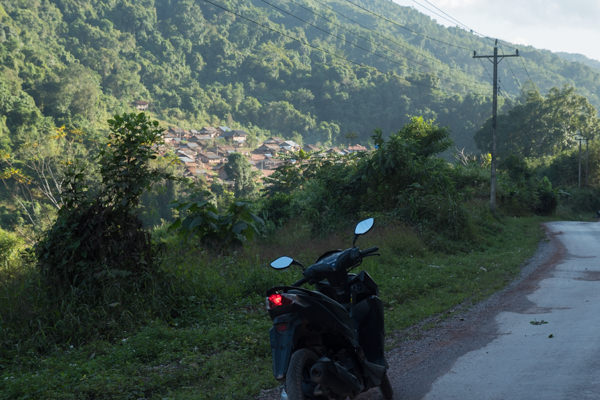
9. Rent a motorbike if you can
Okay, this tip is huge. While you can get to most tourist spots using public buses or tuk-tuks, renting a scooter (motorbike) is a total game-changer.
That is, of course, if you can drive one. If not, make friends with another backpacker who can and maybe you can hop on the back!
Scooters are by far the most popular form of transportation in Asia, so you can rent them pretty much anywhere. This usually costs about $5 ~ $10 a day. It’s extremely liberating to get off the usual trail and travel completely at your own pace.
Do take care though as traffic accidents are by far the biggest danger to travellers in Southeast Asia. Some Western backpackers drive at crazy speeds and end up in horrible accidents. But drive carefully and a whole different side of Southeast Asia will open up to you.
10. Eat the street food!
The street food in Southeast Asia is legendary (and cheap!). Just don’t get too paranoid about any food making you sick as this honestly rarely happens. If it’s fried it’s probably gonna be fine. Unless you’re on a short holiday where absolutely nothing can go wrong, be sure to try the delicious street food. It’s an essential part of the experience.
The one time I got pretty sick in Asia was from a German-style schnitzel I had in a nice restaurant in Indonesia.
Don’t eat schnitzel in Indonesia.
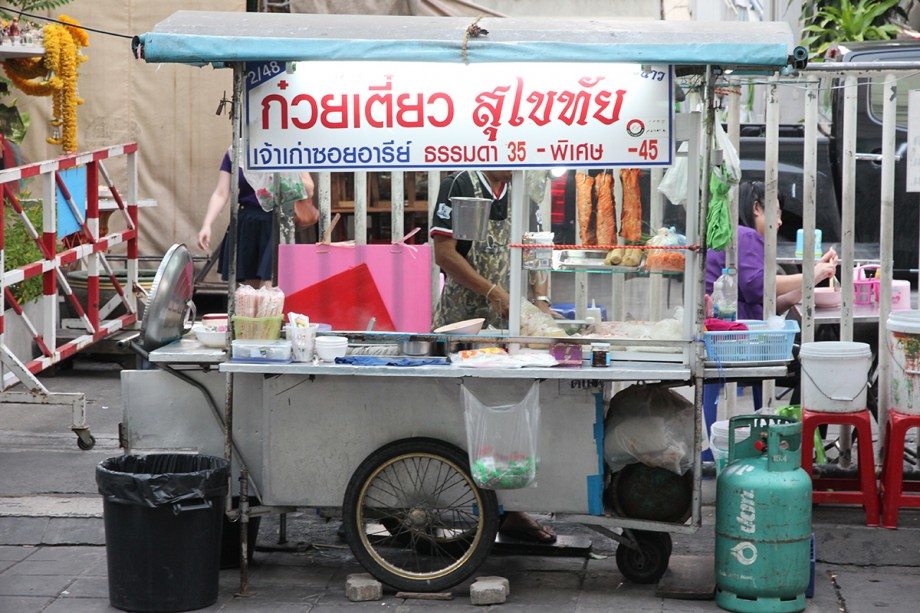
Street food in Bangkok
11. But bring loperamide… just in case
Even though issues are rare, on my many Asia trips I admittedly did occasionally find myself praying to the Porcelain God. It’s a situation that will typically resolve itself in a day or two, but it’s not fun while you’re dealing with it. Buy some loperamide pills (a.k.a. Imodium) as this will stop the flood. You’ll thank me later.
12. Stick to bottled water
Tap water is generally not safe to drink, so best to avoid it. Safe bottled water is available everywhere, though it does feel a bit bad to be buying plastic bottles all the time. One solution is to get a LifeStraw filter bottle, which can make safe drinking water out of any tap water. Make sure you stay hydrated as you’ll need it with those tropical temperatures.
13. Go local and save money
On a budget? Then go for Asian food instead of pizzas or hamburgers. Take public transportation instead of tourist shuttles that you book at local travel agencies. Slowly wean yourself off of air-conditioning so you can get the much cheaper fan-only rooms instead. Backpacking in Southeast Asia gets a lot cheaper when you travel less like a typical high-spending tourist and stick to the budget-friendly options.
14. Ignore a tuk-tuk driver’s advice
The drivers of tuk-tuks and taxis I’ve often found pretty unreliable for information. They’ll often just take you to crappy tourist traps or some random guesthouse where they get a commission for bringing you there. Figure out your own plan first, then tell them where to drive. Unfortunately, the drivers usually cannot be relied upon for good local tips.
15. Kill the flesh-eating bacteria
It took me a while to actually notice this, but it can take a long time for wounds to heal fully in Southeast Asia. A cut that would be easily healed within a week in Europe might still not be closed in Asia after a month. Weird.
One theory I heard is that it’s due to the high humidity. Another is that it’s due to… tropical flesh-eating bacteria. Okay, that sounds a lot worse than it is, but I recommend putting some iodine antiseptic (like Betadine) on any wounds. It will kill any bacteria and allow your wounds to close much more rapidly.
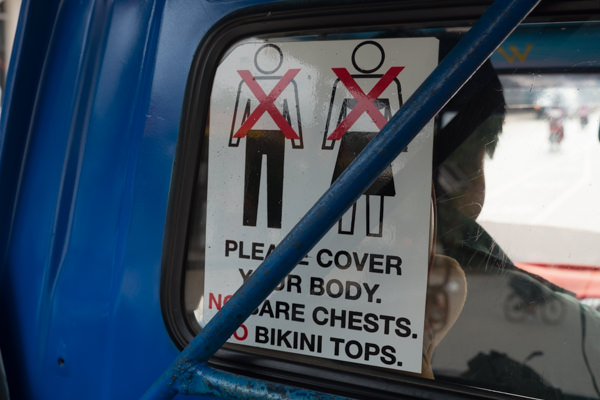
16. Respect the culture
As a guest in each country, it’s a good idea to be aware of the local norms. For example, walking around in a bikini in Laos is akin to walking around butt-naked. This will either not be appreciated at all or appreciated way too much by certain locals. Similar norms exist in (parts of) Indonesia and Malaysia.
Temples and other holy sites almost always require you to dress appropriately, i.e. cover your upper legs or shoulders. Ones that are often visited by tourists might already have sarongs and scarves for you to use.
17. Don’t be a dick to animals
This is more of a public service announcement than a travel tip, but since so many backpackers are unaware, it’s worth repeating it here. It’s best not to engage in typical “animal tourism” in Asia, unless they’re true wildlife experiences or if you can expect high standards of care.
Taking a photo with a tiger in Thailand is not that awesome. That tiger will actually be heavily tranquilized and living an awful life. When these pictures inevitably show up in places like Tinder, very few people are impressed. (See: Tigers of Tinder or this article on tiger selfies.)
Elephant riding sounds fun, but the animals are often horribly abused and traumatized so that they’ll later obey commands. Ethical elephant sanctuaries let you feed and wash the animals, but not ride them.
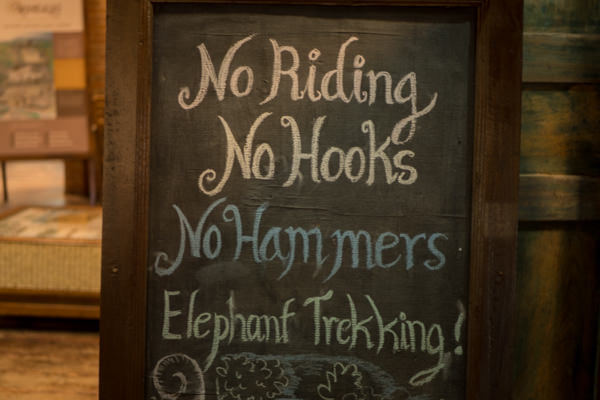
18. Animals might be dicks to you though
Particularly monkeys. They’re proper assholes. Watch your camera, beer, bananas, etc.
19. Take a chance to learn something new
Backpacking in Southeast Asia gives you many opportunities to try or learn new things. It’s a great time to dive into travel photography or to learn Asian cooking, for example. If you’ve got some days to spare, just base yourself in a place where there are courses in rock climbing, muay thai, surfing, or scuba diving. You may not be able to ever do it as cheaply again!

Scuba diving at Palau Sipadan
20. Know your scams
Scams are pretty rare in the grand scheme of things — and they’re usually fairly innocuous in Asia — but you might still encounter one every now and then.
Keep an eye on any taxi meters: they may be rigged up to go many times faster than normal. Be sure to take photos of any equipment you rent, so no one can claim that you damaged it (when in fact you didn’t). Read the scams section of travel guides or travel wikis for more location-specific scams.
21. Beware of the copycats
Guesthouses and restaurants often shamelessly steal the names of other successful businesses. Sometimes they just put a tiny barely-noticeable ‘2’ at the end to avoid infringement. Pay attention so that you end up at the place you were looking for, and not some copycat that’s riding their coattails.
22. Be patient
Not everything runs exactly with perfect efficiency. Delays are common and travel plans can go awry. Take it easy and shrug off the inevitable minor setbacks with a sense of humor. It’s all part of the adventure.
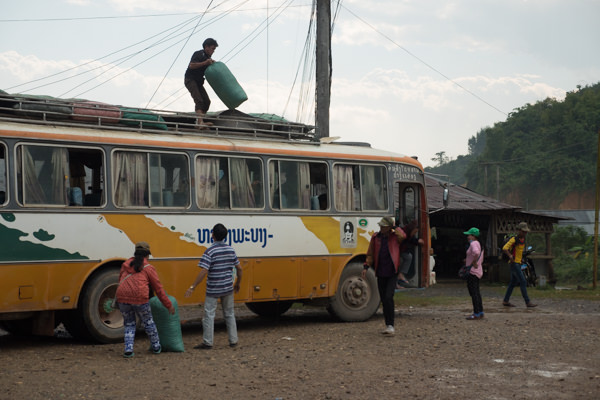
23. There is more than Pad Thais
Food menus in Southeast Asia often start with some generic options like ‘vegetable chicken stir fry’. In Thailand, you’ll also find a dish called Pad Thai, which is simple, cheap, and typically not spicy, so some backpackers end up eating pretty much only this during their trip.
But let’s be honest, it’s pretty boring to just eat these default options!
Don’t miss your chance to order all those flavorful curries, tom yam soups, laap, pho, laksa… the list goes on.
Maybe a good laap (a delicious Loatian minced meat dish) will cost $2.50 whereas a standard vegetable stir-fry might cost just $1.50, but you’ll be missing out if you’re only penny-pinching. If you don’t like spicy, just say “no spicy please”. Or better yet, slowly try to acquire a taste for it… I used to hate it, and now I love it.
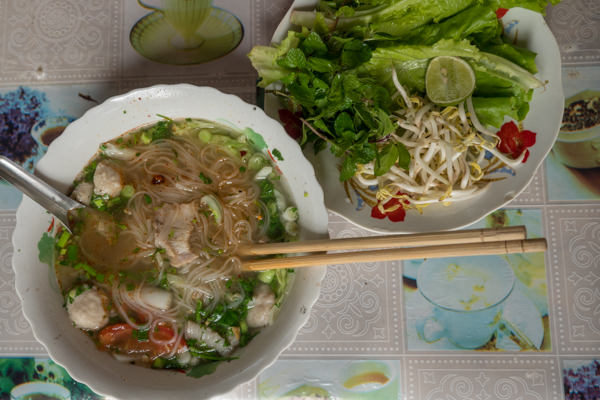
Pho noodle soup
24. Say hi to everyone
Every other traveler is just looking to have fun, so say hi to people and you may make many friends along the way. If you’re going solo, don’t worry; Southeast Asia is a perfect region for travelling solo, as it’s fairly easy to get around and there are typically many other solo travellers too.
25. Throw in a wildcard sometimes
Most backpackers going to Southeast Asia for the first time are obsessed with hitting up all the big and famous locations, like Ha Long Bay or the temples of Angkor Wat. I understand as it’s a natural desire to hit up all the UNESCO World Heritage Sites and such. These places are amazing, but there are also numerous less famous places that are equally worthwhile for different reasons!
I’ve learned that a place doesn’t need to appear on a ranked listicle or promoted by an Instagram influencer (or a blogger like me – hi!) for it to be worth going. Some of the best experiences can be had in the most unexpected places. Every now and then, try taking a random roll of the dice and taking a side-route somewhere.
For more in-depth tips and advice for backpacking in Southeast Asia get a copy of Travel the World Without Worries, your ultimate guide to preparing for a big adventure.
Some links may be affiliate links, meaning I may earn commission from products or services I recommend. For more, see site policies.
Southeast Asia Backpacking Route: The CLASSIC Itinerary

If you’re new to travel in Southeast Asia, you’ll be interested in hitting up the highlights of each country, as well as getting off the beaten track here and there and discovering some hidden gems… Am I right?
The most popular Southeast Asia backpacking route is the most popular route for a reason. It takes in the must-see highlights in the most logical way, avoiding back-tracking and overspending on travel costs. Of course, there are plenty of opportunities to get off the beaten track along the way too. What’s more, the route is so popular that for solo travellers, you can rest assured that you’ll never be lonely! As many backpackers trod the same path, you will meet tons of travel buddies along the way.
In this article, we’ll tell you exactly what the route is, but first, we answer the most burning backpacker question… Where on earth do I begin?

Planning a Southeast Asia Backpacking Trip? Let us help you!
Where is The Best Place to Start Your Backpacking Adventure in Southeast Asia?
Most travellers begin their adventure in Thailand. Why? It’s home to the most well-trodden backpacker trail in Southeast Asia, it’s cheap, safe, the people are friendly, the food is great and most of all, it’s the easiest place to meet travel buddies for your onward adventure!
Most Popular Starting Point: Bangkok
Bangkok is the natural hub for travellers to Southeast Asia. Flights from Europe and the US to Thailand’s capital are fairly cheap and frequent. The city is safe, friendly and one of the easier (we didn’t say easy!) Asian cities to navigate. Plus, there are loads of great sociable hostels where you can meet fellow travellers.

Bangkok has been a backpacker hub for decades. (Pictured: Khao San Road).
Top 3 Hostels in Bangkok to meet people:
Read more about the Best Hostels in Bangkok here.
Second Most Popular Starting Point: Kuala Lumpur
An alternative starting point for your Southeast Asian adventure is Malaysia’s capital, Kuala Lumpur, the home of budget airline, Air Asia. The city also has cheap flights, very good hostels and amazing street food. One disadvantage is that the city is more expensive than Bangkok (and more importantly for some, the beer is more expensive too!).

Kuala Lumpur, Malaysia. (Pictured: Merdeka Square).
Top 3 Hostels in Kuala Lumpur to meet people:
Third Most Popular Starting Point: Bali, Indonesia
Finally, some travellers like to start their backpacking adventure with sun, sea, sand and surf on the tropical island of Bali, one of Indonesia’s best destinations. Particularly for Australian backpackers, Bali is a logical starting point being so close to many major Australian cities. The island is a fun, relaxed and easy place to begin your travels with many great sociable hostels and the chance to meet lots of fellow travellers. There’s also the beautiful Gili Islands and the island of Lombok which you may as well check out if you’re nearby! (For those starting their trip in Bali, the logical thing to do would be to do the following itinerary backwards.)

Bali, nicknamed ‘Island of the Gods’ is a great place to start any adventure!
Top 3 Hostels in Bali to meet people:
Read more about the Best Hostels in Bali here.
The “Banana Pancake Trail” – The Most Popular Southeast Asia Backpacking Route
So here it is, the most popular backpacking route in Southeast Asia… It’s a trail that was originally carved out by the hippies of the 60s and 70s, inspired the birth of the Lonely Planet, and one that backpackers from all over the world continue to mark out today!

Why is the Southeast Asia backpacking trail nicknamed the “Banana Pancake Trail”?
You may have heard it nicknamed the ‘Banana Pancake Trail’ on account of the abundance of banana pancake and other Western food stalls that sprung up to accommodate Western travellers who were following the route. You might have also heard it nicknamed ‘The Golden Circle,’ or simply ‘The Backpacker Circuit’.
The Southeast Asia Circuit: Fast Facts
- START: Bangkok
- FINISH: Kuala Lumpur (shorter route), Bali (longer route)
- Transport: You can complete this route entirely overland using local transport (buses, trains and occasional boats). No flights are needed unless you are particularly short on time.
- Visas: Some visas will need to be arranged in advance. See our Southeast Asia visa guide here.
- Duration: This route is usually completed in 3-6 months.
- Average budget per month: $500-$800 USD. See here for a breakdown of how much it costs to backpack Southeast Asia.
- Best time to go: The most popular time to backpack Southeast Asia is from September to March which misses out the rainy season in most areas. (Rainy season hits most of Southeast Asia from June to August.) However, there are several microclimates, so make sure you check each destination before you travel. See here for a guide to the climate and monsoon seasons of Southeast Asia.
- Travel Insurance: An essential part of any backpacking trip. We recommend the following insurers: 1. Safety Wing Nomad Insurance (covers COVID-19), 2. True Traveller 3. World Nomads.
- Best Hostels in Southeast Asia?Check out some of the best hostels in Southeast Asia here.

What’s the Best Backpack for Travellers?
Osprey’s Farpoint 40 (men) and Fairview 40 (women) are consistently voted the best backpacks for travel.
- Lightweight, Comfortable
- Clamshell Opening
- Lifetime Guarantee
COUNTRY 1: THAILAND (Central and Northern)
Bangkok:
Start in Bangkok (for the reasons above) and spend a few days getting over your jet lag and exploring the city. Many first time travellers choose to stay in Khao San Road or the neighbouring district of Banglamphu, one of the most notorious backpacker ghettos in the whole of Southeast Asia. While you should definitely take a walk down Khao San Road for a drink, a cheap massage and to soak up the lively atmosphere, there are definitely other neighbourhoods in Bangkok to explore!
Chiang Mai:
12-hour train journey or 9-hour bus journey north from Bangkok
Head north to Chiang Mai, the gateway to Northern Thailand, famous for its weekend markets, cultural activities such as Thai Massage, Muay Thai Boxing, Yoga and Meditation. If we had one tip for Chiang Mai, it would be to hire a motorbike and get out of the city to explore! Check out these alternative (and free!) things to do in Chiang Mai here.
- Also, check out our list of the Best Hostels in Chiang Mai!
- Tip – It’s best to avoid Chiang Mai during the months of March/April when the ‘burning season’ occurs.
Sukhothai:
- An optional stop on the way from Bangkok to Chiang Mai
- 5-6 hours north from Bangkok, 4-5 hour south of Chiang Mai
UNESCO World Heritage site, Sukhothai is the old capital of Thailand and is conveniently placed smack bang in the middle of Bangkok and Chiang Mai making it an excellent stopover to break up your journey. It’s a great place to soak up some ancient Thai culture and visit some beautiful temples.
Pai:
3-hour mini-bus ride west from Chiang Mai
From Chiang Mai, head three hours west to the mountainous hippie town of Pai in Mae Hong Son province. From hot springs to waterfalls, canyons, great street food and live music, there are many reasons why backpackers call this one of their favourite hangouts in Thailand. (Worth the puke-inducing journey to get there!)
Mae Hong Son Loop: 3-5 days (Optional)
If you’re looking for an adventure, consider renting a motorbike to do the Mae Hong Son Loop, a 3-5 day journey that takes in some of the best scenery that Northern Thailand has to offer!
Chiang Rai:
4 hours north of Chiang Mai
After making your way back to Chiang Mai, head further north to the smaller city of Chiang Rai. Here don’t miss a visit to the White Temple and the Black House, and if you have time check out the trekking opportunities to indigenous communities that live close by.
Chiang Khong:
2 hours northeast from Chiang Rai
Take a short bus journey to the Mekong Riverside town of Chiang Khong on the border of Thailand and Laos. Here, you will be leaving Thailand for a while to start your Laotian adventure!
COUNTRY 2: LAOS
GETTING TO LAOS: The Two Day Slow Boat from Thailand to Laos
The slow boat from Thailand to Laos is an epic backpacker journey that takes two days along the mighty Mekong stopping one night in the small riverside village of Pak Beng. After you’ve sorted out your visa at the border town of Huay Xai, you’ll board a colourful wooden boat to the city of Luang Prabang, Laos. You’ll experience some amazing scenery (especially on the last day as you are coming into the city of Luang Prabang) and no doubt make travel buddies along the way!
Luang Prabang:
Your first stop in Laos is Luang Prabang, a rather touristy yet undeniably beautiful old town full of old temples, markets and French-style cafés. Get your fill of bread and cakes here! A must-do in Laos is to hire a bicycle and visit the Kuang Si Falls just outside of town.
Nong Khiaw:
3 hours north of Luang Prabang by bus, or 6 hours by boat
If you’re looking to see the most spectacular scenery in Laos, then this is the place to do it! Located on the Nam Ou River and nestled by dramatic limestone cliffs on both sides Nong Khiaw is an adventure lover’s paradise! Trekking, rock climbing and kayaking adventures await. Reach here by boat from Luang Prabang for a truly special experience.
Muang Ngoi:
1 hour by boat from Nong Khiaw
Take a one-hour boat trip for the day or stay overnight in this beautiful village for a slice of the laid-back life that Laos is so famous for. Then, head back to Luang Prabang and continue to Vang Vieng…
Vang Vieng:
3-4 hours south of Luang Prabang
Vang Vieng used to be infamous on the backpacker trail for the dangerous party activity, tubing. It’s since reinvented itself as an eco-travel destination and there are lots of outdoor activities on offer from rock climbing to mountain biking as well as are loads of enticing caves, amazing lagoons and hiking trails to explore.
Vientiane:
3-4 hours south of Vang Vieng
Laos’ sleepy capital, Vientiane, is nothing like the other Southeast Asian cities you’ll have experienced. It would be difficult to get run over here if you tried! Relax while drinking beer by the Mekong, visit some twinkling temples as well as the weird Buddha Park and prepare yourself for your transition to the next country on the list – a place where you definitely can get run over… VIETNAM!
Leaving so soon? Is Southern Laos worth seeing?
Southern Laos has a few delights for the intrepid traveller, such as the popular backpacker hotspot of Four Thousand Islands, as well as the lush coffee-growing region of the Bolaven Plateau. However, many travellers who are planning to travel the length of Vietnam choose to skip Southern Laos and head straight from Vientiane to Vietnam’s capital of Hanoi to begin their North-South Vietnamese adventure. (If you do want to explore Southern Laos at this point, it is possible to cross the border into Vietnam from Cambodia later on… )
COUNTRY 3: VIETNAM
GETTING TO VIETNAM: The epic 27-hour bus journey from Laos to Vietnam
Many backpackers enter Vietnam via the lengthy 27-hour+ bus journey from either Vientiane or Luang Prabang in Laos. It’s an arduous journey that has many horror stories attached to it, but it will certainly give you a story to tell! If you really don’t fancy the bus ride, it’s also possible to take a one hour flight.
Hanoi:
Vietnam’s capital Hanoi is like nowhere you’ve ever been before. Millions of motorbikes whizz past you at all times of day, street food sizzles on the street, locals drink Vietnamese drip coffee and old people do strange exercises in the park. Hanoi is an exhilarating experience and the beer is the cheapest in Southeast Asia!
Sapa:
8 hours north of Hanoi by train (or bus)
An overnight train ride from Hanoi towards the Chinese border will get you to the misty mountain hill-town of Sapa. Sapa is home to the highest mountain in Vietnam (Mount Fansipan) and is the most popular place in Vietnam to go hiking and discover more about Vietnam’s colourful ethnic minorities. After Sapa, head back to Hanoi to make your way to…
Halong Bay:
3 hours east of Hanoi
The UNESCO World Heritage site of Halong Bay is a must-see destination in Vietnam and millions of backpackers each year take a cruise to experience the floating villages, caves and beaches of the area. Whether you’re looking for a relaxing time or a 24-hour booze cruise, the tour you choose will greatly affect your experience of Halong Bay, so make sure you choose it wisely. Check out our guide on choosing the right Halong Bay Tour for you.
Optional Adventure: The Ha Giang Loop – 3 Days
The Ha Giang Loop is quickly gaining a reputation amongst backpackers as the most epic adventure in Vietnam as it showcases some of the most spectacular scenery that the country has to offer! Hire a motorbike from Hanoi or get yourself hooked up with an Easy Rider and set off on this spectacular three-day journey taking in some incredible mountainous landscapes.
Head back to Hanoi – You’ll see that we’ve done this quite a lot, but now it’s time to leave the north of Vietnam behind and head south!
Phong Nha National Park:
9 hours south of Hanoi
An absolute must-stop on the backpacker trail, Phong Nha National Park is home to the world’s biggest cave, Han Son Doong. Although it costs an arm and a leg to visit and there’s a huge waiting list, there are loads of other epic caves in the area to explore, as well as trekking, rafting and biking opportunities.
Ninh Binh (Optional Stopover)
2 hours south of Hanoi
Optional Stop on the way to Phong Nha: If you want to break up the 9-hour journey from Hanoi to Phong Nha, consider stopping at Ninh Binh, famously nicknamed ‘Halong Bay on Land’ it’s home to some beautiful scenery and some relaxing hostels.
Hue:
4 hours south from Phong Nha
The ancient city of Hue is worth a visit for a day or two as you explore Hue’s Citadel and other important buildings. From here, you may choose to take a motorbike or jeep journey over the famous ‘Hai Van Pass‘ (dubbed one of Vietnam’s most beautiful roads) to reach the town of Hoi An.
Hoi An:
3 hours south of Hue
The UNESCO World Heritage city of Hoi An is a must-stop on any tour of Vietnam with its colonial buildings and unique street food. Take a boat trip, a cooking class or hire a bicycle to explore the lovely rice fields and villages around the city. After exploring the city (and getting yourself a tailor-made suit) head to nearby An Bang Beach for some much-needed beach time and try some of the great restaurants there while you’re at it!
Dalat:
12 hours south-west from Hoi An
The high altitude town of Dalat is known as the ‘Alps of Vietnam’ and is famous for its wine, cheese, yoghurt, café culture and outdoor activities. Try canyoning, mountain biking, trekking and other adventure sports in the local area and then indulge in some comforting dairy products that can be more difficult to find in other parts of Southeast Asia.
Nha Trang:
3 hours east by bus from Dalat or a one-day downhill mountain bike ride!
Instead of taking the bus, why not try a unique way to get to the coastal town of Nha Trang from Dalat. Hop on a mountain bike and freewheel all the way! Nha Trang is one of Vietnam’s most famous coastal resort towns, popular for diving, booze cruises and nightlife. Chill out here, meet fellow backpackers and indulge in the tacky backpacker party scene for a few days!
Mui Ne:
4 hours south by bus
Mui Ne is famous for kitesurfing, sand dunes and fishing in that order. The beach is pleasant and it’s a chilled out place to stay for a few days before making your way to the big smoke…
Ho Chi Minh City:
4 hours west of Mui Ne
Ho Chi Minh, Vietnam’s biggest and craziest city can be overwhelming for first-time backpackers. As the last stop on your tour of Vietnam, you should definitely pay a visit to the Vietnam-American War Museum and the Cu Chi Tunnels to get a better understanding of the recent history of the country.
Optional: If you still haven’t got your fill of beaches whilst in Vietnam, why not head to dreamy Phu Quoc Island, a one hour flight from Ho Chi Minh City. A laid-back island of white sandy beaches and turquoise waters.
COUNTRY 4: CAMBODIA
GETTING TO CAMBODIA: Flight or bus to Phnom Penh
You can either take a one-hour flight or a 6-7 hour bus ride across the Vietnam-Cambodia border from Ho Chi Minh City to our first stop, Phnom Penh.
Phnom Penh:
The capital of Cambodia, Phnom Penh, has seen its fair share of tragedy in recent years. A visit to the Killing Fields and S21 Genocide Museum will demonstrate this and is a must-do activity for any traveller who wants to educate themselves about the country.
Kep:
3 hours south of Phnom Penh
Kep is an old colonial beach resort and sleepy fishing village on the Cambodian coast that’s famous for its seafood (most notably crab) and its decaying French mansions. Visit the pepper plantations and explore the flat countryside by motorbike or bicycle.
Kampot: 30 minutes to 1 hour from Kep
Kampot is a favourite amongst long-term travellers who fall in love with this sleepy countryside town and end up staying longer than expected. A visit to Bokor National Park and the Bat Cave are absolute musts.
Koh Rong:
3-4 hours from Kampot
While the once-popular backpacker beach town of Sihanoukville has since turned to rack and ruin, the tropical island paradise of Koh Rong remains intact (for now). It’s a must-visit for backpackers who want to witness an unspoilt side of Cambodia’s coastline with beautiful white sandy beaches and amazing phosphorescent plankton that glows underneath your feet as you walk on the water’s edge. Go now before they build casinos there and while you’re at it, check out some of these other unspoilt Cambodian islands.
Siem Reap:
12 hours by bus
It’s an overnight bus journey to Cambodia’s most popular tourist destination of Siem Reap, home to the world-famous Temples of Angkor, the largest religious building in the world. Every year, millions of tourists flock here annually to wander the immense ruins of this ancient lost civilisation. We recommend that you spend at least three days exploring Angkor Wat, as well as taking some time to soak up what the rest of Siem Reap has to offer, such as the Tonle Sap floating villages, Siem Reap Night Market and of course, Pub Street!
COUNTRY 5: BACK TO THAILAND! (The South)
GETTING BACK TO THAILAND: Crossing the Border
It’s just a 6-hour bus journey from Siem Reap back across the Thai border to the capital Bangkok. Get a sticker on your chest and let’s go! (You’ll see…)
Bangkok:
You’re back in the hubbub of Bangkok! Do some shopping, enjoy some Thai street food, a Thai massage, buy a new bikini (or board shorts) and get ready for some beach time in Southern Thailand!
Bangkok to Surat Thani: Take an overnight train or bus to Surat Thani, the gateway to the Thai Gulf Islands. (9 hours by train. 13 hours by bus.)
Koh Phangan:
3 hours (by boat and bus) from Surat Thani
Many backpackers make a bee-line for the island of Koh Phangan, world-famous for the Full Moon Party. However, Koh Phangan is also well-known for its spiritual new-age scene with yoga classes, meditation courses, tantric workshops, energy healing ceremonies, rebirthing, Reiki, NLP, hypnotherapy, astral-projection and every type of healing therapy you could ever imagine! If you’re not into any of the above, the island has some amazing beaches and snorkelling too.
Koh Tao:
1-hour boat from Koh Phangan
Koh Tao is famous on the Southeast Asia Backpacker scene for diving and it’s the most popular place in Thailand for backpackers to get their PADI or SSI diving licence. A 3-day PADI Open Water Course costs around $300 USD and you’ll then be equipped to dive up to 18 metres anywhere in the world. Keep an eye open for whale sharks! If you’re not into diving, the snorkelling around Koh Tao is great too (and much cheaper)!
Khao Sok National Park:
7 hours bus and mini-van from Koh Tao
Located on the strip of the mainland that separates the East and West coast of Thailand, Khao Sok National Park is home to some Jurassic scenery and epic natural wonders, including the world’s biggest flower, the Rafflesia, which is rumoured to smell like rotting flesh (nice). Go trekking in the jungle, visit caves, stay overnight on a floating hut on the lake and try to spot wild elephants!
Krabi:
2 hours from Khao Sok
Krabi is an unarguably beautiful region of Thailand that is home to the quintessential Thai scenery that is printed on postcards. (Longtail boat with colourful garlands, limestone mountains, translucent turquoise waters – got it?). So is it really like this? You bet it is!
Many travellers are confused between Krabi, the name of the province (which includes Railay, Tonsai and the islands of Koh Lanta, Phuket and koph Phi Phi) and Krabi, the town in Krabi Province. While the town of Krabi is not much to look at, it does make a great jumping-off point from which to explore the rest of Krabi Province’s delights…
Railay and Ton Sai:
30 minutes from Krabi Town by longtail boat
Famous for world-class rock climbing, this peninsular offers some truly spectacular scenery and Railay and Ton Sai Beaches are an absolute must-visit for backpackers. Don’t miss the opportunity to take a day’s rock climbing course, go deep-water soloing, visit the hidden lagoon, go snorkelling at night to see phosphorescent plankton, oh and visit the penis cave! And, when you’ve done all that just chill in the reggae bars in the evening with a cool Chang…
Koh Lanta:
1 hour from Railay
Koh Lanta is an underrated Thai island that has some of the best beaches in Thailand! Hire a motorbike to explore all of the islands beaches, caves and its only national park (watch out for the monkeys!) and when the sun goes down, head to Mong Bar for a great backpacker party!
Optional: Find your own castaway island paradise! From Koh Lanta, it’s possible to hire a long-tail boat to visit one of the lesser-known islands in the Andaman Sea such as tiny Koh Ngai or Koh Pu. (There are many others!) You’ll find a very different scene here away from the tourist beach life and can relax on your own private island paradise for a few nights!
Koh Lipe:
3 hours by boat
Your last stop on the tour of Southern Thailand is Koh Lipe, a beautiful tropical island that has become rather popular of late. However, while it may not be the deserted paradise of old, if you’re looking for white sandy beaches, clear blue seas, as well as awesome snorkelling and diving, Koh Lipe really does have it all, and it just so happens that the island is on route to our next Southeast Asian country…
COUNTRY 6: PENINSULAR MALAYSIA
GETTING TO MALAYSIA: Boat from Koh Lipe to Langkawi
The boat from Koh Lipe, Thailand to Langkawi, Malaysia takes an easy-breezy one hour 30 minutes.
Langkawi islands:
Most backpackers don’t stay here very long as it’s more of a holiday island and more expensive than Thailand’s islands. However, if you choose to linger a while there are plenty of nice beaches, oh and plenty of cheap booze (the island is duty-free).
Penang:
A 2-hour ferry ride from Langkawi
Famous as the food capital of Malaysia, Penang is a fascinating cultural melting pot. Soak up the atmospheric capital of Georgetown, visit Penang National Park and eat as much of the delicious and cheap local cuisine as you possibly can!
Perhentian Islands (Depending on the season):
8-hour bus from Georgetown to Kuala Besut Jetty
The Perhentian Islands are the most popular backpacker beach hangout in Malaysia, in particular, the smaller island Perhentian Kecil. Get ready for amazing snorkelling, diving, relaxing and beach parties! (Note: Monsoon season in the Perhentian Islands is opposite to much of the rest of Southeast Asia hitting the islands November – February. The best time to go is March – November.)
Taman Negara:
3-hour bus from Perhentian Islands
Taman Negara (literally meaning ‘National Park’ in Malay) is a dense rainforest at the heart of Peninsular Malaysia where many nature-lovers go for some serious jungle trekking and wildlife spotting.
Cameron Highlands:
4-hour bus from Taman Negara
The Cameron Highlands in central Peninsular Malaysia is a beautiful and unique destination in Malaysia famous for its misty tea plantations and old colonial British Estates, complete with strawberry farms, golf courses and black and white Edwardian Houses! Go trekking here amidst cooler climes and enjoy a nice cup of soothing tea!
Kuala Lumpur:
Malaysia’s young capital, Kuala Lumpur (KL) is a multi-cultural feast for the senses! Have an Indian thali for breakfast, Chinese wonton for lunch and a Middle-Eastern shwarma for dinner! See the famous Petronas Towers, Batu Caves and even visit a roller coaster inside a shopping mall!
Pulau Tioman (Tropical Side-step from KL):
If you’re craving a tropical island vibe, why not spend a few days on the idyllic paradise of Pulau Tioman, once voted one of the world’s most beautiful islands! Famous for its amazing beaches, unbelievable snorkelling and romantic castaway atmosphere.
Back to Kuala Lumpur
FLYING ONWARD: As the home of Air Asia, flights from Kuala Lumpur are some of the cheapest in Southeast Asia. Book a cheap flight and continue your adventure!
What’s Next on Your Southeast Asia Itinerary?
Singapore:
This city island is only a few hours from Kuala Lumpur, but be warned it will eat into your backpacker budget like a mosquito gnawing at your ankles! Check out the resources below for how to make the most of the city on a backpacker budget.
Borneo Malaysia:
From Kuala Lumpur or Singapore, you can catch a cheap flight to Kuching, the charming capital of Sarawak. Visit tribal long-houses, encounter orang-utans in the jungle, go diving, trek into enormous caves or even climb Mount Kinabalu!
Indonesia:
After completing the above Southeast Asia route, many travellers choose to make their way to Indonesia after visiting Malaysia and (possibly) Singapore. Indonesia is an enormous country made up of over 11,000 islands so there is a lot to explore here!
- Check out this exciting 30-day Indonesia itinerary to get an idea of how you can explore all of the best bits of the country.
Sumatra: Head to the Malaysian port town of Melaka and then catch a ferry to Dumai in Sumatra to start your Sumatra itinerary. In Sumatra, you can head to Bukit Lawang for jungle trekking and orangutan spotting and don’t miss the beautiful Lake Toba or the gorgeous Pulau Weh if you’re into diving.
Java: If you want to head straight to Java, catch a cheap flight and begin your journey in the nation’s capital, Jakarta. Volcanoes, deserted beaches, jungle trekking, the call of prayer, Komodo dragon-spotting and world-class diving await…

The amazing Komodo National Park, Indonesia.
Myanmar: (Depending on the Political Situation).
If you’re intrigued by this ancient kingdom that was closed off to the outside world for so long, the logical place to slot in a visit to Myanmar would be right at the beginning of your trip, whilst you are in Northern Thailand. From Thailand, you can cross the border into Myanmar at Mae Sot and make the lovely town of Hpa An your first stop in Myanmar. Or simply catch a flight from any of the major Southeast Asian hubs to Yangon, the capital of Myanmar. The country has had its fair share of political strife in recent years, so be sure to check local news channels before travelling.

The magnificent temples of Bagan, Myanmar.
Philippines:
It takes a flight to get here folks, which makes the Philippines somewhat of a separate destination for backpackers to Southeast Asia. However, those travellers who make the effort have nothing but awesome things to say about this magical country of 7,107 islands.
5 Tips on Planning Your Own Southeast Asia Travel Route!
I’m sure you’ll realise that the above route is only a guideline and there are many factors that make your Southeast Asian adventure unique. Here are 5 important things to consider when planning your trip:
1. TIME: How Long Do You Have to Travel the Southeast Asia Route?
Again and again, I see newbie backpackers posting a suggested itinerary in our Facebook Community that is beyond ambitious. The main mistake that new travellers make is to cram too many places into too small a time frame. This not only wreaks havoc on your budget, but you will tire yourself out and just won’t see the best of each country! Trust us – the true joy comes with slow travel. Allow extra time to linger in each place and flexibility for your plans to change, or better still, don’t plan much at all!
2. BUDGET: How Much Money Do You Have?
While most of Southeast Asia is accessible on a budget, if you’re travelling on a shoestring, you’ll want to avoid certain places (e.g. Singapore, Hong Kong, Koh Phi Phi) and linger a while in places where beds, food and beer are cheap. Read our comprehensive guide to planning the cost of your backpacking trip in Southeast Asia and if you’re travelling on a shoestring, be sure to check out this article on the cheapest places in Southeast Asia here.
3. SEASON: What Time Of Year Will You Travel Southeast Asia?
In general, most of Southeast Asia has a monsoon season from July to September. High season is October to February and the hot season is March to June. However, it’s wise to check up each destination before you visit as there are many different microclimates across the region and some destinations have a monsoon season that’s completely different from the rest of the country, (the east coast of Malaysia, or the central coast of Vietnam, for example.)
4. TRANSPORT: Local Transport Vs Flights
Do you want to travel only overland visa buses, trains and tuk-tuks? Or, would you be happy to get the odd flight here and there? There are many benefits of taking local transport over flights: you’ll have a more local experience, you get to look out of the window, you’ll save money and it’s better for the environment etc. However, flights in Southeast Asia are cheap, safe and quick and great for those of you who are short on time. Some great local budget airlines include AirAsia, Nok Air, Vietnam Airlines, Jetstar Airways, 12GO Asia and Bangkok Airways. Compare prices on Skyscanner.
5. ON OR OFF THE BEATEN TRACK: You Can Have Both!
The beauty of the “most popular” travelling Southeast Asia route is that there are plenty of opportunities to sidestep and get off the beaten track. You’ll find it ridiculously easy to get away from the tourists and into places where locals are surprised to see you. Often it’s just a few timid footsteps away from the main path. Do it!
One Final Tip – If you’re mulling over your Southeast Asian itinerary and not sure whether you’ve planned a good route, don’t be afraid to post it in the South East Asia Backpacker Community and get some feedback and advice from fellow backpackers!

Nikki Scott | Founder & Editor
Nikki is the founding editor of South East Asia Backpacker and The Backpacker Network. In her early twenties, she left her home in the North of England on a solo backpacking adventure and never returned! After six months on the road, she founded a print magazine that became legendary on the Banana Pancake Trail. The rest is history.
Find me: Facebook | Twitter | Instagram
Join Over 20,000 Happy Backpackers in Our Facebook Group!
Find travel buddies. Get advice. Have all your questions answered by travellers on the ground in Southeast Asia right now.
Source https://www.kiwi.com/stories/packing-list-backpacking-through-southeast-asia/
Source https://www.indietraveller.co/backpacking-in-southeast-asia-tips/
Source https://southeastasiabackpacker.com/backpacking-route-southeast-asia/